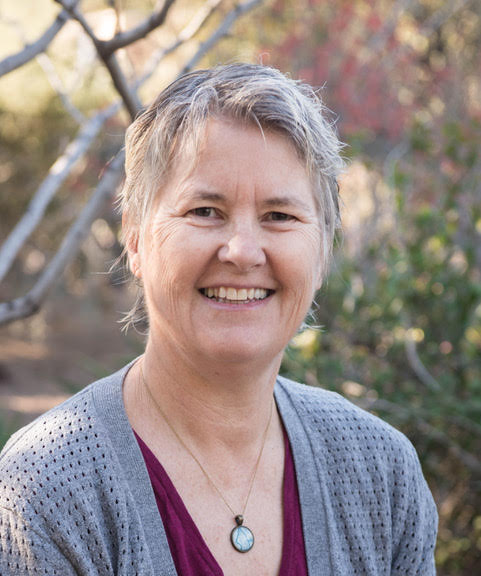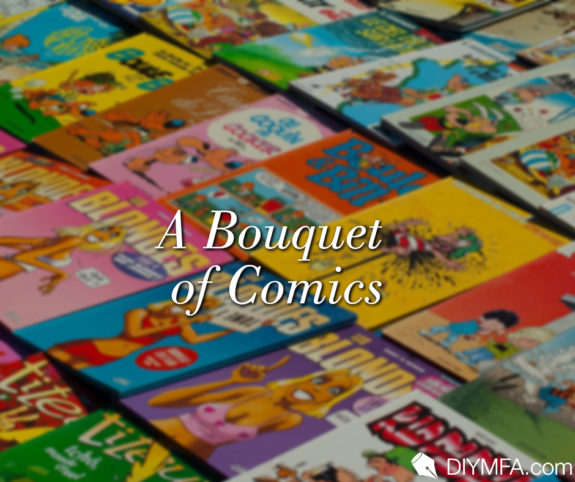My first deep impression of anthologies was as texts in poetry school. I still have a shelf dedicated to these early intros to poetry: The Norton Anthology of Modern Poetry, Imagist Poetry: An Anthology, Great Poems by American Women: An Anthology. In the literary arts, collections like these register a kind of arrival to such a degree the word has become an adjective. To become anthologized signals acceptance into the literary big leagues. Or so I thought.
I love etymology, but not once until today did I look up the origins of anthology. To my delight, it derives from flowers and the human propensity to gather them together. How, as a lover of words and gardens had I missed this connection?
My go-to source for word origins is a two-volume Oxford English Dictionary I keep by my desk that I now need a magnifying glass to read.
Anthology: a flower-gathering; a collection of the flowers of verse.
The word compounds from two ancient Greek words, anthos meaning flower and logia referring to a collection of writing. What makes the OED an adventure in squinting are the extracted quotes included to establish a word’s journey through the panoply of work printed in English. From the entry for anthology, I find this quote:
“In the anthologies of earth…one flower beyond every other is liable to change, which flower is the countenance of woman.”
Thanks, Thomas De Quincy for that gem from your 1822 memoir Confessions of an opium-eater. A classic mansplain of a woman’s nature. What a chuckle.
The Best American Comics
Still, I love that the word once meant a gathering of flowers. It brings the literary anthology out of the dusty storage bin of textbooks to offer color and beauty to the world. My brief etymological research has given me a kinder view of anthologies as a species of book, one I will apply to reviewing the latest issue of The Best American Comics, guest edited by cartoonist Jillian Tamaki.
Since 2006, Houghton Mifflin Harcourt has been publishing these annual anthologies of comics. Each guest editor sifts through hordes of submitted work from the previous year to gather together a bouquet of comics. Each issue combines the art of the times with the tastes and intentions of the guest editor. Of course, reader preferences come into play, which is no doubt why the series has different guest editors each year, not just to expand the boundaries of bestness, but to attract new readers by offering more diversity in selections.
How to read an anthology of comics?
It’s a book, so the first instinct is to start at the beginning and slog through to the end, but once upon a time…the end is hardly how one enjoys a collection of flowers in a vase or in a garden. The eye scans the scene, delighting in singular blooms at the same time appreciating the overall composition and the effect of contrast, texture and color. A well-designed garden or flower arrangement begs a meandering kind of enjoyment. This garden-stroll approach works for reading anthologies, especially those that are visual.
To enter into an anthology of comics, first scan, then read, and by read I mean look more carefully at the drawings and read the words, simultaneously. As with flower bouquets or planted mixtures of blossoms, an anthology editor can arrange work so it comes together to create connections that one might not notice if taken in isolation. Too many of the same kind of flower or too much uniformity between plants in a garden breeds boredom. Too much variety could be amazing or confusing, depending on how it’s arranged.
A scan through the 2019 anthology reveals restraint in color, a spectrum of greens balanced against bright primary hues and tempered by a large field of black and white comics. My eye falls on “Vanguard” by Leslie Stein, the splashes of watercolor and loose lines appealing to my nature. I’m further intrigued by how Stein draws to music, something I’ve been doing for a few years as well. It’s awesome how much expression her characters convey when they often have just two tiny dot eyes to signify a face. The sequence of panel-free vignettes follows a narrative exploration of drawing to music, ending in her experience of drawing to live jazz at the Village Vanguard in New York. The writing is introspective and funny.
“Vanguard” is my favorite flower in the bunch, but you may pick another. Such is the abundance of bouquets.
What comics do that a bouquet of flowers likely won’t is expose social injustice and personal torment. The 2019 Best American Comics includes excerpts from work that navigates the balance between being a mother and an artist, the urgency of finding friendship at summer camp as an immigrant child, the struggle of finding intimate human connection after the death of a transexual spouse. It grapples with thin interpretations of Martin Luther King Junior’s legacy, faces climate change while on a road trip, reveals the sad futility of explaining polyamorous relationships with nonbinary lovers to a sick mother who won’t stop saying ‘he’ when ‘they’ is what’s desired.
Comics gathered together in the 2019 Best American Comics represent much of what makes comics art compelling. How they draw you close with the craft of line and get you to linger with their stories. How they stay in your heart after you return them to your anthology shelf. Like a garden lures bees with its beautiful blooms, and, once-sated, off they buzz, their bodies dusted with pollen, ready to help make flowers bloom elsewhere.

Rebecca Fish Ewan, a poet/cartoonist/writer and founder of Plankton Press, teaches landscape architecture at Arizona State University. She grew up in Berkeley, California, and now lives in Arizona with her family. Her recent books: By the Forces of Gravity, a cartoon/poetry memoir, and coming this Fall (June release delayed due to pandemic) Doodling for Writers (Books by Hippocampus). You can connect with her at rebeccafishewan.com







